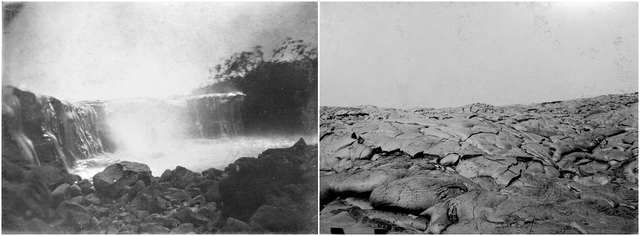Volcano Watch: Why you’ve never heard of Hilo’s Kalanakamaa gulch
In 1880-81, a lava flow from Mauna Loa came very close to entering Hilo Bay. In trying to reconstruct the timeline of this flow for a recent Volcano Awareness Month presentation, we tracked down many old place names mentioned in newspaper reports of the lava’s progress. One such name that came up repeatedly is Kalanakamaa gulch (“kahawai o Kalanakamaa”).
ADVERTISING
The first place we saw this name is the 1870s description of the boundary between the ahupua‘a of Waiakea and Kukuau. The boundary goes mauka from the shoreline through several points within the Waiolama fishponds (area of today’s Hilo Bayfront soccer fields) to Kumu spring (just north of the Downtown Longs Drugs). From there, it continues upslope to Kalanakamaa across what is now Kilauea Avenue. The record of this boundary was based on testimony by several kama‘aina from the area.
In 1881, Joseph Nawahi, a well-known Hilo lawyer, painter and politician, wrote letters about the Mauna Loa flow to Hawaiian language newspapers. As the flow neared Hilo in June 1881, he described the lava descending into the Kaumana stream and forecast that it would arrive on the Kalanakamaa gulch adjacent to Kukuau Street in Hilo.
The Kalanakamaa place name appears several times in 1881, mostly in Hawaiian-language newspaper accounts of the Mauna Loa eruption. By the end of July, the lava flow was reported to be in Kalanakamaa gulch before it stalled in early August 1881.
The next time this place name is mentioned in detail is in testimony recorded by the Boundary Commission in 1900. The exact location of the boundary between the ahupua‘a of Waiakea and Kukuau was being disputed, and lawyers for both sides needed to clearly define each point in its description.
A typical example of a kama‘aina description of the boundary went like this: “… thence to Kumu, on the banks of the Waialama [Waiolama] river thence to Kalanakama [Kalanakamaa ]where the Government road to the volcano runs through the land thence to Huia ….”
One of the main questions the lawyers asked each witness was for the definition of Kalanakamaa. Was it a rock, a tree, a pile of rocks, a gulch?
The name literally means “remove sandals or shoes,” but many witnesses identified Kalanakamaa as a specific breadfruit tree at the intersection of a big gulch and the road to Volcano. Apparently, Hawaiians traveling from Puna to Hilo on this road wore ti-leaf sandals over the rough lava of Waiakea, but took them off and hung them in the breadfruit tree before going on to the soft ashy soil of Hilo.
It became apparent during our research that the Kalanakamaa name also applied to the adjacent gulch, which carried water when it rained, sometimes overflowing its banks. A bridge was built over the gulch prior to 1881, but it had washed away. All witnesses who described seeing water in the gulch said it went dry after the “flow of ’81.”
An unnamed gulch in the area described by kama‘aina is shown on a map from the 1870s (available from Hawaii State Land Survey archives). In a 1954 aerial photo, a gulch in this same area is visible about 100 yards north of and parallel to Hualalai Street, from Kilauea Avenue to the police department on Kapiolani Street. We interpret these features to be the Kalanakamaa gulch. Dry since 1881 and largely filled in by subsequent construction, the gulch no longer exists.
From our research, it’s clear that the 1880–81 Mauna Loa lava flow significantly changed the way streams drained into Hilo Bay. Lava flowed downstream channels, filling some and diverting water into others, such as Alenaio to the north of Kalanakamaa and Waiakea to the south.
This has happened repeatedly in the Hilo area. For example, there’s evidence of filling and diversion by lava flows along the Wailuku River, where the Boiling Pots area shows the remains of two such lava fillings in the past 10,000 years.
It’s not surprising if you’ve never heard of Kalanakamaa gulch. On a volcanic island such as ours, rivers and streams are temporary features that often change or vanish as lava flows alter the landscape.
Volcano activity updates
Kilauea continues to erupt at its summit and East Rift Zone. During the past week, the summit lava lake level was relatively stable, varying between about 36 and 38 m (118–125 ft) below the vent rim within Halema‘uma‘u Crater. On the East Rift Zone, scattered lava flow activity remains within about 6 km (4 mi) of Pu‘u ‘O‘o and is not currently threatening nearby communities.
Mauna Loa is not erupting. Seismicity remains elevated above long-term background levels. Continuously recording GPS instruments show deformation related to inflation of a magma reservoir beneath the summit and upper Southwest Rift Zone of Mauna Loa, with inflation recently occurring mainly in the southwestern part of the magma storage complex.
There were no earthquakes reported felt on the Island of Hawaii during the past week.
Visit the HVO website (http://hvo.wr.usgs.gov) for past Volcano Watch articles, Kilauea daily eruption updates, Mauna Loa weekly updates, volcano photos, recent earthquakes info, and more; call for summary updates at 808-967-8862 (Kilauea) or 808-967-8866 (Mauna Loa); email questions to askHVO@usgs.gov.
Volcano Watch (http://hvo.wr.usgs.gov/volcanowatch/) is a weekly article and activity update written by scientists at the U.S. Geological Survey`s Hawaiian Volcano Observatory.




